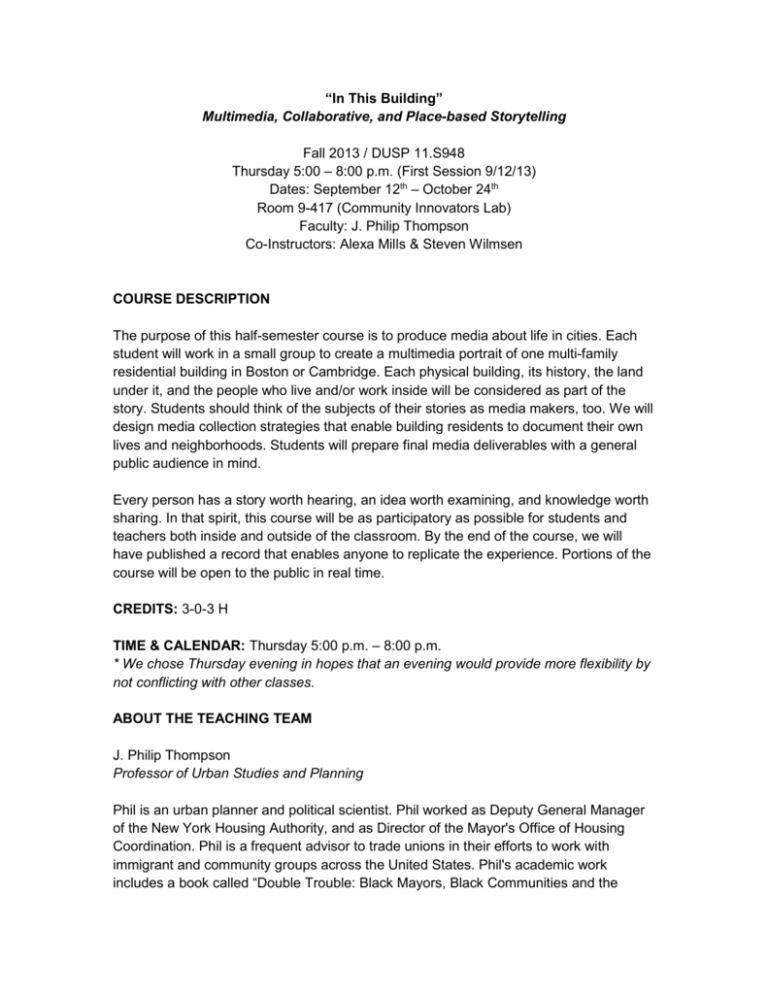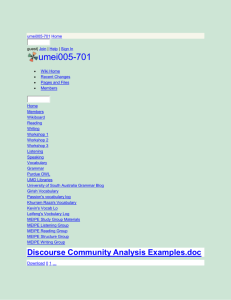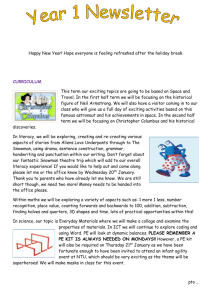In_This_Building_083013
advertisement

“In This Building” Multimedia, Collaborative, and Place-based Storytelling Fall 2013 / DUSP 11.S948 Thursday 5:00 – 8:00 p.m. (First Session 9/12/13) Dates: September 12th – October 24th Room 9-417 (Community Innovators Lab) Faculty: J. Philip Thompson Co-Instructors: Alexa Mills & Steven Wilmsen COURSE DESCRIPTION The purpose of this half-semester course is to produce media about life in cities. Each student will work in a small group to create a multimedia portrait of one multi-family residential building in Boston or Cambridge. Each physical building, its history, the land under it, and the people who live and/or work inside will be considered as part of the story. Students should think of the subjects of their stories as media makers, too. We will design media collection strategies that enable building residents to document their own lives and neighborhoods. Students will prepare final media deliverables with a general public audience in mind. Every person has a story worth hearing, an idea worth examining, and knowledge worth sharing. In that spirit, this course will be as participatory as possible for students and teachers both inside and outside of the classroom. By the end of the course, we will have published a record that enables anyone to replicate the experience. Portions of the course will be open to the public in real time. CREDITS: 3-0-3 H TIME & CALENDAR: Thursday 5:00 p.m. – 8:00 p.m. * We chose Thursday evening in hopes that an evening would provide more flexibility by not conflicting with other classes. ABOUT THE TEACHING TEAM J. Philip Thompson Professor of Urban Studies and Planning Phil is an urban planner and political scientist. Phil worked as Deputy General Manager of the New York Housing Authority, and as Director of the Mayor's Office of Housing Coordination. Phil is a frequent advisor to trade unions in their efforts to work with immigrant and community groups across the United States. Phil's academic work includes a book called “Double Trouble: Black Mayors, Black Communities and the Struggle for Deep Democracy” published in 2006 by Oxford University Press. He is currently writing a book on community building and development since the 1960s. Alexa Mills Director of Media Projects at MIT Community Innovators Lab Alexa is the Media Projects Program Director at MIT Community Innovators Lab. Alexa founded CoLab Radio, a blog site where people who are committed to improving their communities can share their projects and express their ideas. She publishes work by a mix of practitioners, academics, and individual residents on the site. Steven Wilmsen Enterprise Editor at The Boston Globe Steven is the narrative editor, overseeing long-term and news feature stories on the Metro desk. He is the author of a book, “Silverado: Neil Bush and the Savings and Loan Scandal,” and his recent projects have earned him the National Headliner Award, Casey Medal, and Dart Award. Steven edited the breakthrough “68 Blocks” multimedia series about the Bowdoin-Geneva neighborhood in Dorchester. COURSE DELIVERABLES Students will work in small groups. Each group will produce a multimedia deliverable that tells the story of life in one multi-family dwelling in Boston or Cambridge. For example, you may produce a mini-documentary about friendships and feuds between neighbors. Or you may create a web-based audio feature describing the way in which a building sounds, or a soundscape about children in the building. You could also build an interactive timeline of the history of this building. Instructors will help you plan an appropriate and feasible deliverable. We will explore data collection, production, and presentation techniques throughout the course. We will also include participatory media strategies for interested building residents. In addition, each student will write at least one blog post for CoLab Radio. LEARNING MEDIA PRODUCTION Mini media production clinics, on topics such as video editing, et cetera, will be available to students as needed. Students can use writing, photography, video, infographics, data, maps, audio, and web design as they see fit. PROPOSED CALENDAR MON Sept – 2 8 16 23 TUES 3 10 17 24 WED 4 11 18 25 THURS 5 12 Class 1 19 Class 2 26 Class 3 FRI 6 13 20 27 SAT 7 14 21 28 SUN 8 15 22 29 30 7 14 21 Oct – 1 8 15 22 2 9 16 23 3 Class 4 10 Class 5 17 Class 6 24 Class 7 4 11 18 25 5 12 19 26 6 13 20 27 TOOLS FOR COLLABORATIVE LEARNING Etherpad Type your notes in to the class etherpad: http://brownbag.me:9001/p/In_This_Building. The idea is that we can all learn from each other and we should share collective knowledge throughout the course. The etherpad has its own unique URL so the notes will be available even after the course is over. Using the etherpad is easy. Once you click the link, you can type into it. Each person can pick his or her representative color via the legend in the top right corner. Twitter If you do not have a twitter account, we ask that you create one to use throughout the course. In the etherpad, each student should include his twitter handle so we can all follow one another and engage with each other in and between classes. Blogging We would like to archive this course and your experiences on MIT CoLab’s blog, CoLab Radio. We will publish one post after each class session to document the learning process. By the end of the course, the full blog series will make the course replicable to any group wishing to conduct a similar course. The notes from the etherpad should help you write these posts. Posts should be 400-600 words long and can include photos, videos, and audio. READING LIST All readings are available at MIT Libraries. All movies, audio, photos, and interactive web features are available online. 1. Anderson, Elijah. A Place On the Corner. University of Chicago Press. 1976. 2. Arroyo, John. Art and Culture Mapping on the LA River. CoLab Radio. Boston. 2010. - Introduction and map 1: http://bit.ly/13KJbsf - Map 2: http://bit.ly/1eqxRq8 - Map 3: http://bit.ly/1eqxUCv - Map 4: http://bit.ly/16swCUQ - Map 5: http://bit.ly/13KJvXV 3. Cisneros, Sandra. The House on Mango Street. Vintage Books: A Division of Random House, Inc. New York. 1989. 4. Cizek, Katerina. Highrise / Out My Window. National Film Board of Canada. 2011. http://interactive.nfb.ca/#/outmywindow 5. Dawson, Brian and Michael Kolomatsky, Stacy Abramson, Alicia DeSantis, Beatrice de Gea. Beyond the Stoop. The New York Times. 2010. http://www.nytimes.com/interactive/2010/07/25/nyregion/25oneblockinteractive.html?ref=nyregion&_r=0 6. DeCarava, Roy and Langston Hughes. The Sweet Flypaper of Life. Simon and Schuster, Inc. New York. 1955 7. Irons, Meghan E. and Akilah Johnson, Maria Cramer, Jenna Russel,and Andrew Ryan. Ed. Steven Wilmsen. 68 Blocks: Life, Death, Hope in Boston’s Most Troubled Neighborhood. The Boston Globe. 2013. http://www.bostonglobe.com/metro/specials/68blocks * Read all five articles, watch videos, and view all media features included in sidebar on the right side of webpage 8. Forester, John. Planning in the Face of Power. Chapter seven, “Listening: The Social Policy of Everyday Life”. University of California Press. 1989. 9. Marcus, Claire Cooper. House As a Mirror of Self: Exploring the Deeper Meaning of Home. Nicolas-Hays, Inc. 2006. Berwick, Maine. 10. Ossard, Claudie. Le fabuleux destin d'Amélie Poulain. Mirimax. 2001. *We will watch selections in class. You do not need to watch the entire film. 11. Tichy, Jan. Project Cabrini Green. Chicago. 2011. http://projectcabrinigreen.org/ COURSE SCHEDULE Please read “68 Blocks: Life, Death, Hope in Boston’s Most Troubled Neighborhood” before week 1. Week 1 - Introductions - Frame the class, set expectations, introduce shared learning platforms - “Telling the Story of a Place / Bowdoin-Geneva” lecture & discussion - Schedule one-on-one meetings with students to discuss goals, ideas, neighborhoods, and media production experience/goals Assignment: Complete all course readings. In addition, find one reading or web feature that you feel fits in with the rest of the list. Plan a 5-minute presentation on the reading or web feature that you would add to the list. This week’s blog post: A participation guide for people who would like to follow this course from a distance, plus a summary of the official reading list. Week 2 - Students present their selected media - Discussion of shared readings and web features - Discuss potential buildings to study Assignment: Scour Boston and Cambridge in search of a building that you would like to research for the duration of the course. Conduct preliminary interviews and research. Come to the week 3 class prepared to present your findings. This week’s blog post: A round-up post featuring some of the readings and web features that students selected to add to the official course list. Week 3 - Students present preliminary research on specific buildings (Why that neighborhood? Why that building?) - Discuss findings - Choose groups and sites Assignment: Make a list of all the information you need about your building. Include quantitative, structural, and historical information. Who do you want to interview? What historical data do you need? How will you get it? Divide the list with between your group member(s) and begin collecting information. This week’s blog post: Write a reflection on what it was like to search for a site. Include maps and photos of your process. Week 4 - “Engaging current residents” lecture and discussion - Students present lists and their research thus far. Students exchange ideas about what information is important and how to get it. Alter research plans accordingly. - One-on-one meetings with course instructors Assignment: Continue research. Write an outline and/or draft a visual representation of your final deliverable. This week’s blog post: Write a reflection on what it’s like to research your site. Include links to your best sources and explain your challenges. Include photos, maps, images, audio files, and video as necessary. Week 5 - Present a first draft of your final deliverable. Class will discuss challenges, opportunities, and solutions together. - One-on-one meetings with course instructors Assignment: Continue developing your final deliverable. This week’s blog post: None. Week 6 - Present an improved draft of your final deliverable. - One-on-one meetings with course instructors Assignment: Finalize your building profile. This week’s blog post: During weeks 6 and 7 students will have the opportunity to present each building portrait. Week 7 Students will share their final deliverables to a panel of planners, journalists, featured building residents, and other guests. Blog post: During weeks 6 and 7 students will have the opportunity to present each building portrait. Course instructors will write a wrap-up of the final presentation.





